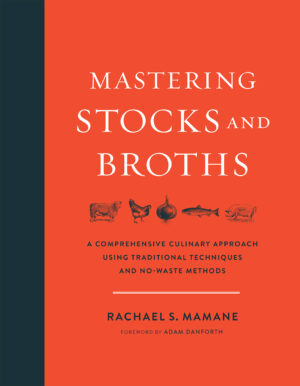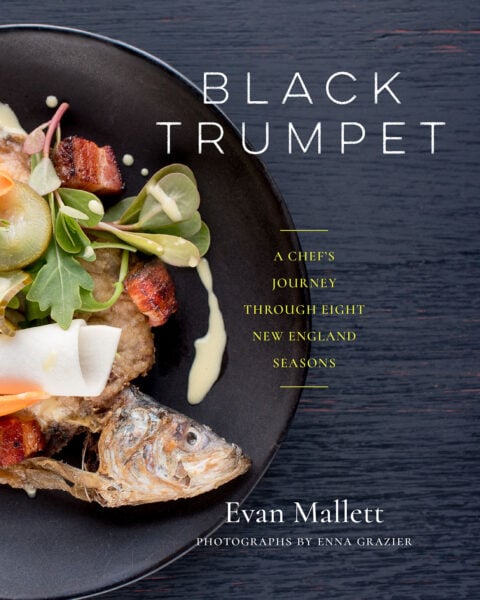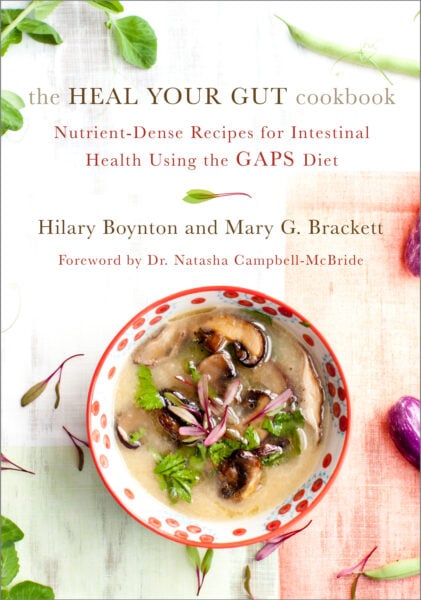Stocks and Broths: The Etymology
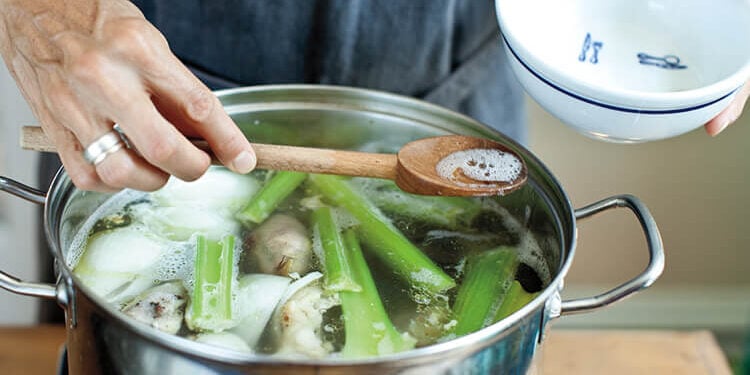
Question: When you make soup, do you start with stocks or broths? Answer: It depends.
To help clear up any culinary confusion here’s an excerpt from Mastering Stocks and Broths by Rachel Mamane
Understanding The Etymology of Stocks and Broths
There is much modern-day confusion about the difference between stock and broth. Culinary definitions vary from commercial interpretations. Nutritionists base their distinction on nutrient density of gelatin and mineral content rendered from bones. To further confuse you, chefs often use the terms interchangeably. Sir Balthazar Gerbier’s proverb, “Too many cooks spoil the broth,” seems appropriate here.
To understand the difference, you must start with a fond, the French culinary term for foundation. To the French, stocks are considered le fond de cuisine— the essence of ingredients diffused in water, to be used as a building block for cooking. A fond can start with bones and water in a stockpot or develop into a sauce when crusty bits of meat and juice on the surface of a pan are loosened by deglazing with water, stock, or wine. Stock, then, is the foundation by which a broth—the collection of ingredients suspended in stock—is built.
Let’s dig a little deeper into the etymology of stocks and broths. The word stock is of Germanic origin, meaning “trunk” in Old English. Similarly, stock is commonly used to reference shipbuilding materials and has evolved to have many related meanings around the idea of supplies and foundation.3 A wordsmith can have fun with the word stock, illustrating its use across many industries, from nance to rearms, finding all roots in the strength of a foundation.
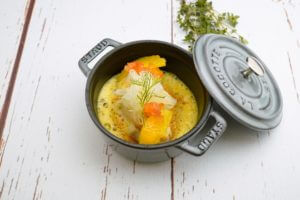 While stocks have presumably been around since the discovery of fire, their first codified use for culinary application was in the eighteenth century when sauces were categorized within the classic French system. Stock was used as a general term to refer to the foundation of cooking: the use of basic materials to bring harmony and balance to a dish. Stocks were intended to be a fundamental ingredient, full of bones and clarified in advance of building soups and stews, used for braising meats and generally adding character to dishes that appeal to the eye. Georges Auguste Escoffier, often referred to as the father of modern French cookery, said of sauce made from stock: The partie capitale of cuisine!4
While stocks have presumably been around since the discovery of fire, their first codified use for culinary application was in the eighteenth century when sauces were categorized within the classic French system. Stock was used as a general term to refer to the foundation of cooking: the use of basic materials to bring harmony and balance to a dish. Stocks were intended to be a fundamental ingredient, full of bones and clarified in advance of building soups and stews, used for braising meats and generally adding character to dishes that appeal to the eye. Georges Auguste Escoffier, often referred to as the father of modern French cookery, said of sauce made from stock: The partie capitale of cuisine!4
By contrast, broth is a more specific term with Germanic roots going back to 1000 CE. Broth is related to the Old English words bru, or brew, and refers to a substance that is prepared by boiling.5 From its earliest documentation, a broth could be vegetable or animal; by the seventeenth century, it was largely associated with a meat base. Traditionally, broth contains more meat than bones and is simmered for a shorter period of time before getting strained and seasoned. Today this definition extends to extracting the essence from vegetables, not only bones. The goal is to develop a light, flavorful liquid that is served as a part of the dish itself. Think of broth as the enhanced liquid in your bowl.
Similarly, the French word bouillon means “liquid in which something has boiled.” Credit for the invention of bouillon is given to the Duke of Godfrey, who was said to have developed a clear, flavorful soup in his castle in Bouillon, Belgium. It wasn’t until the early twentieth century that bouillon was processed into a granulated cube.
The Italians use the term en brodo, literally “in broth,” to describe dishes that use an animal or vegetable stock as its own broth. Tortellini is often seen en brodo. Matzah ball soup can be considered the Jewish version of en brodo, using chicken stock as the base by which to oat the matzah balls.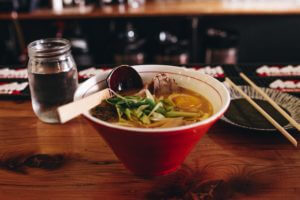
Other examples of broth include Vietnamese pho and Japanese dashi, two highly aromatic bases upon which to add meat or sh, vegetables, and herbs. Another popular Japanese broth is ramen: It develops a complex flavor by first simmering kelp and mushrooms, and then boiling pork belly and pork bones— all in the same batch of water. The goal here is to extract flavor from the seaweed and mushrooms (without introducing bitterness), followed by a session with meat and bones over higher heat to instill loads of taste and texture into the liquid. This type of broth is less about clarity and more about flavor.
Over the years and across many cultures, nutritionists have taken cues from Jewish mothers, Chinese acupuncturists, and Victorian tea parties to examine the healing properties of bone broths. The word restaurant, meaning “to restore to a former state,” derives from a fortifying meat-based elixir that was served in French establishments of the same name. A bone broth, then, is an animal stock that uses collagen-rich bones and simmers for an extended time to maximize gelatin extraction into the liquid.
Bone broth is built similarly to traditional stock but differs in a few ways: 1. Bones are always meaty and full of collagen. 2. Bones might be soaked in vinegar before simmering, a step believed by some to aid the leaching of minerals. 3. Bones are simmered longer than a stock. is process ensures a healthy rendering of gelatin in the liquid, which can di er from a traditional stock in the quantity absorbed by, and clarity of, the final liquid. A nutritionist also cares less about clearness of liquid and more about the concentration of nutrients.
Fallon and her partners have written extensively about bone broths. eir assessment goes beyond the common cross-cultural belief that chicken soup is soothing for colds: Gelatin is known to easily absorb into the body and aid digestion. Bone marrow contains cells that might assist in building immunity and repairing wounds. Cartilage, the connective tissue found in beef knuckles and chicken feet, is believed to fortify joints.6 Compared with store-bought stocks, there is no question that a homemade stock or broth is more nutritious. Still, there is research to be done on the potential bene ts of bone broths. is book evaluates factors, such as time and temperature in a stockpot, that affect the composition of stocks and broths.
Conversationally, it is easy to refer to stock (the foundation) and broth (the composite liquid) as the same; after all, the distinction is technical and lends itself to overlap in the kitchen. In this book, stock is approached from its use in a professional kitchen using French culinary technique: It reflects the steps a chef takes to produce a clarified essence. Broth, when referenced on its own, is reserved for finished dishes. A few recipes highlight different methods to develop stocks and broths from around the world, all preceded by an explanation of their distinction. On the other hand, bone broth is approached from the nutritionist’s perspective and refers to a stock that is customized to extract as much gelatin from the bones and mineral content from other source ingredients as possible, but without losing culinary integrity.
Notes
1. Sally Fallon Morell, “Broth Is Beautiful,” The Weston A. Price Foundation, January 1, 2000, http://www .westonaprice.org/health-topics/broth-is-beautiful.
2. “The State of the Specialty Food Industry 2016,” Specialty Food Association, March 30, 2016, https://www.specialtyfood.com/news/article /state-specialty-food-industry-2016.
3. Harold McGee, On Food and Cooking: e Science and Lore of the Kitchen (New York: Scribner, 2004).
4. Auguste Escoffier, Escoffier: Le Guide Culinaire, Revised (New Jersey: Wiley, 2011).
5. McGee, On Food and Cooking.
6. Sally Fallon Morell and Kaayla T. Daniel, Nourishing Broth: An Old-Fashioned Remedy for the Modern
Recommended Reads
A Good Stock Takes Time: Setting Up Your Kitchen for Making Stocks and Broths
Recent Articles
Garlic mustard: while known as “invasive,” this plant can be consumed in its entirety and has great nutritional value. Plus, the garlic-flavor is a perfect addition to any recipe that calls for mustard! The following are excerpts from Beyond the War on Invasive Species by Tao Orion and The Wild Wisdom of Weeds by Katrina…
Read MoreOh, honeysuckle…how we love thee. If only there was a way to capture the sweet essence of this plant so we could enjoy it more than just in passing. Luckily, foraging and some preparation can help make that happen! Here’s a springtime recipe that tastes exactly like honeysuckle smells. The following excerpt is from Forage,…
Read MoreIntroducing…your new favorite brunch dish! This whole broccoli frittata is packed with fresh, wildcrafted flavors that are bound to help you start your day off on the right foot. The following is an excerpt from The Forager Chef’s Book of Flora by Alan Bergo. It has been adapted for the web. RECIPE: Whole Broccoli Frittata…
Read MoreWondering where to forage for greens this spring? Look no further than hedges, which serve as natural havens for wild greens and herbs! The following is an excerpt from Hedgelands by Christopher Hart. It has been adapted for the web. Food from Hedges: Salads and Greens Let’s start by looking at all the wild foods…
Read MoreThere’s a whole new world out there when it comes to koji. It doesn’t matter if you’re making bread, cheese, or ice cream, koji helps you pump up the flavor! Growing Koji in Your Own Kitchen Koji, the microbe behind the delicious, umami flavors of soy sauce, miso, fermented bean sauce, and so many of…
Read More

